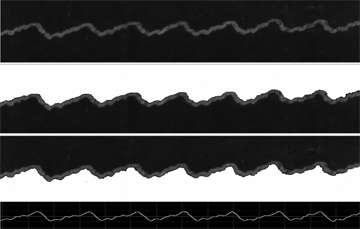 |
Experimental Eduction ProjectsNOTE: This initial account of methods for transducing images into sound—first posted in 2009—is maintained here for its historical interest. You can also find it archived in Archive.org's Wayback Machine. For current information, please visit griffonage.com. |
What do I mean by "experimental eduction projects"? Well, eduction is the word I used in my dissertation to refer to the generation of sounds from a phonogram ("sound recording"), since it doesn't always make sense to call this "reproduction." According to the OED, to educe is "to bring out, elicit, develop, from a condition of latent, rudimentary, or merely potential existence." Many of the inscriptions dealt with here won't be "sound recordings" in the sense we usually understand. But my goal has been to play them—to educe them—just as directly and automatically as if they were.
|
 |
Paleospectrophony
Read here about experiments at educing historic inscriptions of sound through reverse Fourier analysis—a method that allows us to "play" everything from early spectrograms to barrel organ programs to medieval music manuscripts much as though they were ordinary "sound recordings." Optical Sound Track Method
Read here about my method for playing oscillographic representations of sound, including phonautograms, by treating them as optical film sound tracks. |



